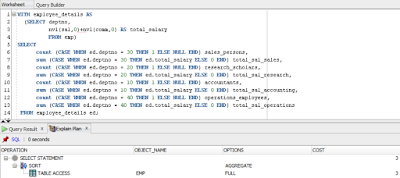I had a question on my mind that, which is the most efficient way to print totals and subtotals in a single row.
I was thinking PIVOT would be the significant way compare to case statement. Let's see which is more efficient way to do that?
Here I am giving an example to write a SQL query that performs a aggregate functions(count, sum, avg and etc) of a column while including case statement.
Step 1: Create DEPT table which will be the parent table of the EMP table.
DROP TABLE dept;
------------------------------------------------------------
CREATE TABLE dept
(
deptno NUMBER(2,0),
dname VARCHAR2(14 BYTE),
loc VARCHAR2(13 BYTE),
CONSTRAINT pk_dept PRIMARY KEY (deptno) ENABLE
);
Step 2: Insert row into DEPT table using named columns.
INSERT INTO dept (deptno,dname,loc) VALUES (10,'ACCOUNTING','NEW YORK');
INSERT INTO dept (deptno,dname,loc) VALUES (20,'RESEARCH','DALLAS');
INSERT INTO dept (deptno,dname,loc) VALUES (30,'SALES','CHICAGO');
INSERT INTO dept (deptno,dname,loc) VALUES (40,'OPERATIONS','BOSTON');
Step 3: Create the EMP table which has a foreign key reference to the DEPT table. The foreign key will require that the DEPTNO in the EMP table exist in the DEPTNO column in the DEPT table.
DROP TABLE emp;
------------------------------------------------------------
CREATE TABLE emp
(
empno NUMBER(4,0),
ename VARCHAR2(10 BYTE),
JOB VARCHAR2(9 BYTE),
mgr NUMBER(4,0),
hiredate DATE,
sal NUMBER(7,2),
comm NUMBER(7,2),
deptno NUMBER(2,0),
CONSTRAINT pk_emp PRIMARY KEY (empno) ENABLE,
CONSTRAINT fk_deptno FOREIGN KEY (deptno) REFERENCES dept (deptno) ENABLE
);
Step 4: Insert row into EMP table using named columns.
INSERT INTO emp (empno,ename,JOB,mgr,hiredate,sal,comm,deptno) VALUES (7369,'SMITH','CLERK',7902,to_date('17-DEC-80','DD-MON-RR'),800,NULL,20);
INSERT INTO emp (empno,ename,JOB,mgr,hiredate,sal,comm,deptno) VALUES (7499,'ALLEN','SALESMAN',7698,to_date('20-FEB-81','DD-MON-RR'),1600,300,30);
INSERT INTO emp (empno,ename,JOB,mgr,hiredate,sal,comm,deptno) VALUES (7521,'WARD','SALESMAN',7698,to_date('22-FEB-81','DD-MON-RR'),1250,500,30);
INSERT INTO emp (empno,ename,JOB,mgr,hiredate,sal,comm,deptno) VALUES (7566,'JONES','MANAGER',7839,to_date('02-APR-81','DD-MON-RR'),2975,NULL,20);
INSERT INTO emp (empno,ename,JOB,mgr,hiredate,sal,comm,deptno) VALUES (7654,'MARTIN','SALESMAN',7698,to_date('28-SEP-81','DD-MON-RR'),1250,1400,30);
INSERT INTO emp (empno,ename,JOB,mgr,hiredate,sal,comm,deptno) VALUES (7698,'BLAKE','MANAGER',7839,to_date('01-MAY-81','DD-MON-RR'),2850,NULL,30);
INSERT INTO emp (empno,ename,JOB,mgr,hiredate,sal,comm,deptno) VALUES (7782,'CLARK','MANAGER',7839,to_date('09-JUN-81','DD-MON-RR'),2450,NULL,10);
INSERT INTO emp (empno,ename,JOB,mgr,hiredate,sal,comm,deptno) VALUES (7788,'SCOTT','ANALYST',7566,to_date('19-APR-87','DD-MON-RR'),3000,NULL,20);
INSERT INTO emp (empno,ename,JOB,mgr,hiredate,sal,comm,deptno) VALUES (7839,'KING','PRESIDENT',NULL,to_date('17-NOV-81','DD-MON-RR'),5000,NULL,10);
INSERT INTO emp (empno,ename,JOB,mgr,hiredate,sal,comm,deptno) VALUES (7844,'TURNER','SALESMAN',7698,to_date('08-SEP-81','DD-MON-RR'),1500,0,30);
INSERT INTO emp (empno,ename,JOB,mgr,hiredate,sal,comm,deptno) VALUES (7876,'ADAMS','CLERK',7788,to_date('23-MAY-87','DD-MON-RR'),1100,NULL,20);
INSERT INTO emp (empno,ename,JOB,mgr,hiredate,sal,comm,deptno) VALUES (7900,'JAMES','CLERK',7698,to_date('03-DEC-81','DD-MON-RR'),950,NULL,30);
INSERT INTO emp (empno,ename,JOB,mgr,hiredate,sal,comm,deptno) VALUES (7902,'FORD','ANALYST',7566,to_date('03-DEC-81','DD-MON-RR'),3000,NULL,20);
INSERT INTO emp (empno,ename,JOB,mgr,hiredate,sal,comm,deptno) VALUES (7934,'MILLER','CLERK',7782,to_date('23-JAN-82','DD-MON-RR'),1300,NULL,10);
------------------------------------------------------------
Workaround: The following SQL statement finds the number of employees and total salary of each department.





Comments
Post a Comment